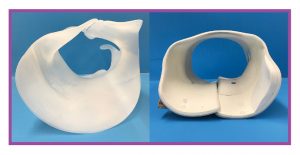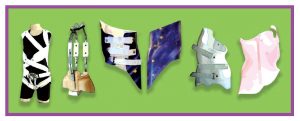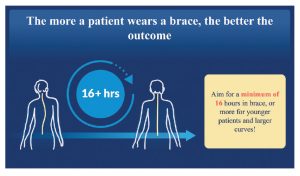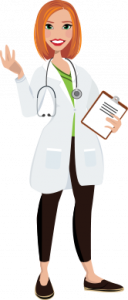Scoliosis Bracing
Bracing treatment is typically recommended after the curve has reached 25 degrees, but this may not be the case in every patient depending on their age, skeletal maturity, and additional factors. Several types of braces exist, such as the Boston style TLSO (thoracic-lumbar-sacral orthosis) brace, Milwaukee brace, Charleston bending brace, Providence brace, and a New York RC brace (NYRC brace). They are all designed to prevent progression of the spinal curve. Advances in brace design have allowed for more comfortably fitting braces. If your brace is uncomfortable, it is important to speak with your Orthopaedic Surgeon as well as your orthotist. They may want to take updated xrays to see if the curve has progressed; evaluate whether you have outgrown the brace; or make changes to the brace. If the brace is comfortable then there is a higher chance that you will be able to obtain the number of hours in the brace that is recommended.
Time in the brace
For the TLSO and the NYRC brace, it is recommended that you wear the brace 15-18 hours a day. In a recent study published by the NIH, the effect of the brace is determined by the number of hours in a brace as well as the fit of the brace. You can find more information about the study at this link: http://www.nih.gov/news/health/sep2013/niams-19.htm
If you wear the brace less than the recommended 15-18 hours a day, it is more likely that the curve is going to progress and ultimately require surgical treatment. Provided there is no further curve progression, the brace is usually worn until an adolescent reaches full physical maturity, a point that varies in age for different individuals. We use hand bone age xrays to help us determine when it is the right time to wean out of the brace. Typically we will first wean the brace to nighttime only and then at the next visit if there is no further progression, discontinue the brace all together. Once the brace has been discontinued, some patients experience some back pain. This is because your core muscles/back muscles can become weak from the immobilization while in the brace. It is important that while you are wearing the brace to do exercises to maintain your core. If you do experience back pain after you discontinue the brace, please speak with your Orthopaedic Surgeon. We may prescribe some physical therapy to work on your core muscles and decrease the pain.
Brace follow up
Once you have been measured and fit for the brace, the orthotist will go over with you a brace schedule to wean into the brace. The brace is like a new pair of shoes so it takes some time to get used to it and to be able to obtain the 15-18 hours a day. Once you reach the 15-18 hours a day, then we will have you follow up with our Nurse Practitioner, Jenn Hope to obtain an xray in the brace. This will occur about 6-8 weeks after you receive the brace. It is important that the brace is correcting the curve which is why we initially obtain an xray in the brace. For all of your other scoliosis follow up appointments, we will obtain xrays out of the brace to see whether the curve has progressed or not. At those visits you must be out of the brace for 24 hours prior to the xray so there is not a brace effect on the curve.
Brace Follow Up Protocol Paper for papers to print
Types of braces
In our practice, we typically use the TLSO and the New York RC brace. Here is some additional information about each of these braces.
- The TLSO Brace
The TLSO braces utilize a custom made to measurement design. It works by applying three-point pressure to the curvature to prevent its progression. The individual patients orthosis is constructed using the radiograph-based blueprint designed by the orthotist. - The New York RC Brace (NYRC brace) is based on the tried and true principles of Dr. Manuel Rigo and Dr. Jacques Cheneau, while maximizing in-brace frontal curve correction and sagittal balance, specific to your patient’s native pelvic incidence. The 3D biomechanical design of the NYRC brace complements the Schroth Physical Therapy Method. To slow the scoliosis curve progression Schroth therapists teach patients to improve their postural alignment with specific exercises and positions. The NYRC brace helps to achieve the greatest 3D in-brace correction possible, contributing to the schroth treatment, exercises, and physical therapy. Sagittal balance has proved important in adult spinal deformity, maintenance of balance during scoliosis treatment has lasting effects. Both the therapists and the bracing system work to achieve this goal.
The NYRC Brace is a highly customized orthosis manufactured with the most advanced CAD/CAM technologies, and it has been developed to provide, for each case, the most reliable and effective results during the conservative treatment of idiopathic scoliosis. Each NYRC brace is carefully designed and fabricated in New York (U.S.A.). - John Tunney BOCPO NYRC brace Expert and East Coast Orthotic & Prosthetic Corp. are available directly in our office so that you are able to see them at the time of visit with your physician.
For more information on the New York RC brace, please call East Coast Orthotic & Prosthetic Corp. at 631-392-2237 or visit http://www.ec-op.com to learn more about the NYRC brace. - The Rigo System Chêneau brace (RSC brace)
Rigo Cheneau braces along with Schroth physical therapy, are gaining major traction in this country due to movements like the support group Curvy Girls. To learn more about Curvy Girls, please visit their website at www.curvygirlsscoliosis.com.

“Rigo style” bracing: A number of Orthotists are making “Rigo style” braces, which are “asymmetrical” and focus on three-dimensional correction. These braces are highly customized and are contoured in all three dimensions to achieve greater success of three-dimensional correction of scoliosis.
Brace resources
Here are some tips and tricks to help make wearing a brace easier. If you have any issues or concerns about your brace, please remember to reach out to your orthotist or your Orthopaedic Surgeon.
- The undershirt you wear underneath the brace is very important. Something relatively tight fitting, seamless, and sweat wicking are all qualities to look for. This can greatly increase the comfort.
Websites that sell comfortable tank tops for underneath the brace:
www.hopescloset.com
www.embracedincomfort.com - You can find some clothing recommendations in the book “Straight Talk With The Curvy Girls”. There is a whole section of the book devoted to how to make it easier to dress with a brace on. http://www.straighttalkscoliosis.com/index.html
- Always bring your brace, x rays, and appropriate clothing with you to your visit with the doctor and the orthotist. An example of clothing would be a snug fitting t shirt and leggings.
- Call your orthotist immediately if you are having brace fit issues. You do not need to wait to see the doctor for these issues to be resolved.
- Always make sure that your brace is on correctly. In most bracing systems the waist is well defined and this should be the landmark for correct brace wear. If the waist is positioned properly the rest should fit as designed. Fitting the NYRC brace lying down can make a big difference.
- View the conservative care pamphlet that is about the conservative care program.
- Read What to Expect: Non-Operative Scoliosis Care
Research articles
- Effects of bracing in adolescents with idiopathic scoliosis. Weinstein SL, Dolan LA, Wright JG, Dobbs MB. N Engl J Med. 2013 Oct 17;369(16):1512-21.
- The effect of compliance to a Rigo System Cheneau brace and a specific exercise programme on idiopathic scoliosis curvature: a comparative study: SOSORT 2014 award winner. Rivett L, Stewart A, Potterton J. Scoliosis. 2014 May 30;9:5.
- Factors associated with the success of the Rigo System Chêneau brace in treating mild to moderate adolescent idiopathic scoliosis. Ovadia D, Eylon S, Mashiah A, Wientroub S, Lebel ED. J Child Orthop. 2012 Aug;6(4):327-31
- A specific scoliosis classification correlating with brace treatment: description and reliability.
Rigo MD1, Villagrasa M, Gallo D. Scoliosis. 2010 Jan 27;5(1):1. - In-brace correction of the Cobb angle with RSC-CAD CAM compared with ‘hand made’ from the original author. Rigo et al. Scoliosis 2010, 5 (Suppl 1): O68
- Quality Control of Idiopathic Scoliosis Treatment in 147 Patients While Using the RSC® Brace. Gallo, D., Wood, G., Dallmayer, R. J Prosthetics and Orthotics 2011; Vol 23, Num 2, p 69
- Effectiveness of the Rigo Chêneau versus Boston-style orthoses for adolescent idiopathic scoliosis: a retrospective study. Minsk et al. Scoliosis and Spinal Disorders 2017; 12:7
Resources







